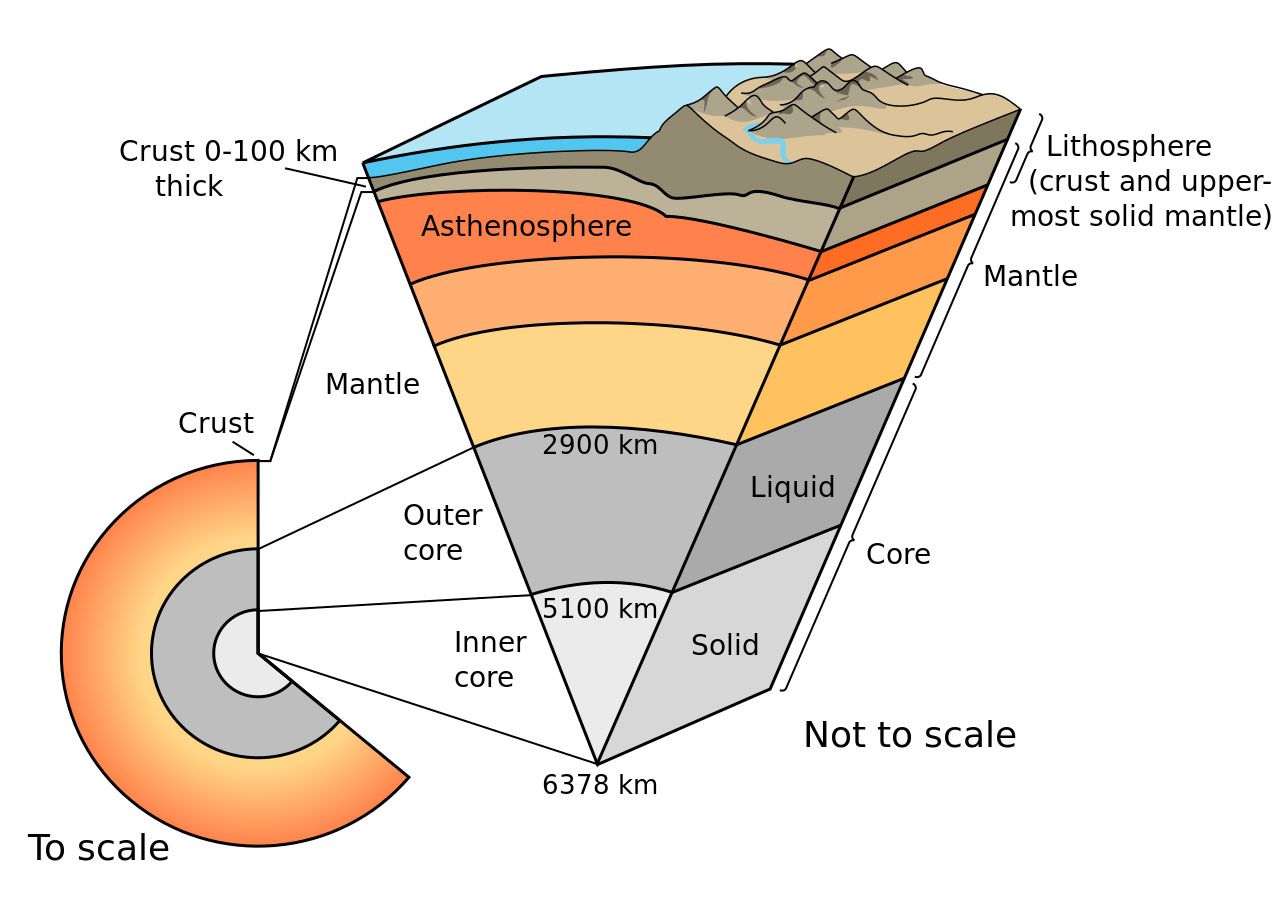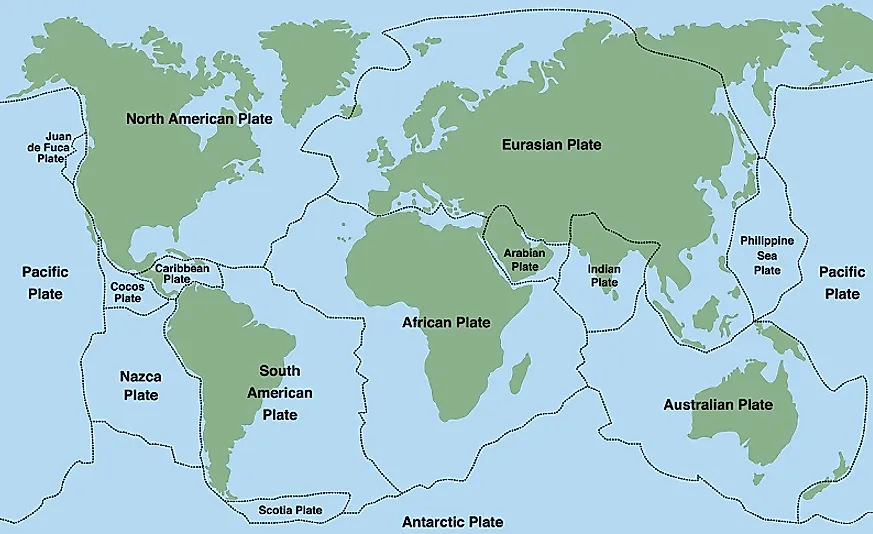-
 Michael McMahon
542The sense of touch is inside the brain so when you feel the back of your head that’s actually a lot closer to your visual screen than it appears. The tactile sensation of your head exists inside the brain itself!
Michael McMahon
542The sense of touch is inside the brain so when you feel the back of your head that’s actually a lot closer to your visual screen than it appears. The tactile sensation of your head exists inside the brain itself! -
 Michael McMahon
542Electromagnetism is stronger than gravity over short distances. So forces like friction between our feet and the ground means we don’t fully experience gravity by itself. Maybe if there was no such thing as friction we’d feel the Earth’s internal rotation from night to day.
Michael McMahon
542Electromagnetism is stronger than gravity over short distances. So forces like friction between our feet and the ground means we don’t fully experience gravity by itself. Maybe if there was no such thing as friction we’d feel the Earth’s internal rotation from night to day. -
 Michael McMahon
542
Michael McMahon
542
We tend to think the brain is behind where we feel our eyes to be. Although we also view colours as being internal which seems to contradict the previous sentence. If the visual cortex is situated at the rear of the brain then perhaps most of our brain is located in front of our field of view. The invisible brain could be interpreted to be behind the image we see. In this comparison the non-conscious eyes passively collects external light and the brain reorganises it to create the qualia in front of us. It may appear counterintuitive to non-neuroscientists that the visual cortex is at the back of the brain. If I never saw a brain diagram before I’d be tempted to think the visual cortex would be right behind the eyes or scattered throughout the brain. Instead the optic nerve goes to the opposite end of the skull. -
 Michael McMahon
542Instead of asking where’s our consciousness perhaps we need to first check where is our brain!
Michael McMahon
542Instead of asking where’s our consciousness perhaps we need to first check where is our brain! -
 Michael McMahon
542There’s little relative motion between our brain and our eyes, head or body. Your eyes are always a certain distance away from the visual cortex. So if we’re not directly conscious of our body then its motion doesn’t have to be palpable. What if we could walk numbly without a sense of touch in our legs? Then our brains could be perceived as motionless relative to our consciousness.
Michael McMahon
542There’s little relative motion between our brain and our eyes, head or body. Your eyes are always a certain distance away from the visual cortex. So if we’re not directly conscious of our body then its motion doesn’t have to be palpable. What if we could walk numbly without a sense of touch in our legs? Then our brains could be perceived as motionless relative to our consciousness. -
 Michael McMahon
542If the mind is separate from the body under dualism then it wouldn’t have to move.
Michael McMahon
542If the mind is separate from the body under dualism then it wouldn’t have to move. -
 Michael McMahon
542The body moves but the brain is always in the same location in the body. Moreover the skull protects it from accelerating.
Michael McMahon
542The body moves but the brain is always in the same location in the body. Moreover the skull protects it from accelerating. -
 Michael McMahon
542Parallax can be inferred from horizontal eye positions and also slanted or vertical eye positions when you rotate your head. There’s a plethora of parallax cues for depth when you rest your head on your shoulder and close one eye after the other. It’s easier for those like myself who’ve spent years learning to wink with both eyes!
Michael McMahon
542Parallax can be inferred from horizontal eye positions and also slanted or vertical eye positions when you rotate your head. There’s a plethora of parallax cues for depth when you rest your head on your shoulder and close one eye after the other. It’s easier for those like myself who’ve spent years learning to wink with both eyes! -
 Michael McMahon
542Saccades are involved in moving our small central vision to look at objects. If the image we see is 2D then the micro-parallax of saccades could help explain why we can automatically and subconsciously see in 3D.
Michael McMahon
542Saccades are involved in moving our small central vision to look at objects. If the image we see is 2D then the micro-parallax of saccades could help explain why we can automatically and subconsciously see in 3D. -
 Michael McMahon
542If we were somehow conscious during a saccade then we’d be momentarily cross-eyed.
Michael McMahon
542If we were somehow conscious during a saccade then we’d be momentarily cross-eyed. -
 Michael McMahon
542Can there be two Boltzmann brains?! If I’m a Boltzmann brain then so are you! We’d be in a universe of interacting brains!
Michael McMahon
542Can there be two Boltzmann brains?! If I’m a Boltzmann brain then so are you! We’d be in a universe of interacting brains!
https://m.youtube.com/watch?v=NhjAKTZhUS4&t=185s -
 Michael McMahon
542If we had the capacity to mentally time travel forward then we could skip the disordered states of dreams and only remember our organised conscious thoughts. This would decrease entropy.
Michael McMahon
542If we had the capacity to mentally time travel forward then we could skip the disordered states of dreams and only remember our organised conscious thoughts. This would decrease entropy. -
 Michael McMahon
542Our voice in our head can sometimes be guided by subvocalising and so our motor system is in sync with our consciousness.
Michael McMahon
542Our voice in our head can sometimes be guided by subvocalising and so our motor system is in sync with our consciousness. -
 Michael McMahon
542Science often conveniently approximates the world as physical seeing as physical objects are by definition impersonal and objective. Historically science was always committed to experimentation, counter-argumentation and the logical analysis of data but not necessarily materialism. For instance a platonic interpretation of mathematics isn’t based on materialism but on the reality of abstract numbers. Subjects like psychology and social science are still objective even though they deal on a more holistic, abstract and metaphorical scale than physics.
Michael McMahon
542Science often conveniently approximates the world as physical seeing as physical objects are by definition impersonal and objective. Historically science was always committed to experimentation, counter-argumentation and the logical analysis of data but not necessarily materialism. For instance a platonic interpretation of mathematics isn’t based on materialism but on the reality of abstract numbers. Subjects like psychology and social science are still objective even though they deal on a more holistic, abstract and metaphorical scale than physics. -
 1 Brother James
41Prior to referring to the "MIND," one might insure that one Knows that the two dimensions of the MIND [or I-MIND] are Invisible to the physical brain. That is, the Lower MIND represents the Astral Region of Creation, while the Higher MIND represents the Causal Region of Creation. Neither of these realms can be perceived by the physical brain [which is a unique muscle located in the skull]. Peace
1 Brother James
41Prior to referring to the "MIND," one might insure that one Knows that the two dimensions of the MIND [or I-MIND] are Invisible to the physical brain. That is, the Lower MIND represents the Astral Region of Creation, while the Higher MIND represents the Causal Region of Creation. Neither of these realms can be perceived by the physical brain [which is a unique muscle located in the skull]. Peace -
 javi2541997
7.1k
javi2541997
7.1k
Which are the differences between "Astral Region of creation" and "Causal Region of creation?"
Why the brain is not involved in those at all? -
 Michael McMahon
542I’m not a mathematician but I remember reading that all of the infinite number of natural numbers add up to -1/12. Maybe there will be a counterintuitive answer in the future. Or maybe it’s a sarcastic result that suggests maths has conscious and immaterial features. The result is irrational in the semantic sense of the word; as if it were arbitrarily picked out of thin air! The square root of -1 is an imaginary number that has no physical analogy even though it’s a useful abstraction. Can there be some “absurd” elements to maths?
Michael McMahon
542I’m not a mathematician but I remember reading that all of the infinite number of natural numbers add up to -1/12. Maybe there will be a counterintuitive answer in the future. Or maybe it’s a sarcastic result that suggests maths has conscious and immaterial features. The result is irrational in the semantic sense of the word; as if it were arbitrarily picked out of thin air! The square root of -1 is an imaginary number that has no physical analogy even though it’s a useful abstraction. Can there be some “absurd” elements to maths? -
 Michael McMahon
542Perhaps the equations have their own sense of humour! Not technically random but capricious and whimsical!
Michael McMahon
542Perhaps the equations have their own sense of humour! Not technically random but capricious and whimsical! -
 Michael McMahon
542We can’t make perfectly random sequences with chaotic mathematical equations and therefore random number generators have a spectrum of unpredictability. What if it were the other way round where we had to check if a sequence was truly random? If there was primordial randomness in our reality, how could we tell?
Michael McMahon
542We can’t make perfectly random sequences with chaotic mathematical equations and therefore random number generators have a spectrum of unpredictability. What if it were the other way round where we had to check if a sequence was truly random? If there was primordial randomness in our reality, how could we tell?
https://stackoverflow.com/questions/14321616/is-it-possible-to-prove-if-a-sequence-is-random -
 Michael McMahon
542An interesting feature of the -1/12 result is that it’s legible which is surprising given the infinite number of possibilities. For instance it’s not an unreadably incomprehensible number like the number 1 trillion 2 billion and 3! This implies if the answer was caused by a hidden process that it would have to have been in operation since the beginning of the infinite addition. This doesn’t appear to be the case when we add the early numbers 1+2=3 and so on. So the answer wasn’t randomly selected out of all available numbers in the sample space of the infinite sequence. The -1/12 answer just appears ad hoc in the whole scheme of things! It’s random in the illogical sense of the word rather than the unpredictable sense.
Michael McMahon
542An interesting feature of the -1/12 result is that it’s legible which is surprising given the infinite number of possibilities. For instance it’s not an unreadably incomprehensible number like the number 1 trillion 2 billion and 3! This implies if the answer was caused by a hidden process that it would have to have been in operation since the beginning of the infinite addition. This doesn’t appear to be the case when we add the early numbers 1+2=3 and so on. So the answer wasn’t randomly selected out of all available numbers in the sample space of the infinite sequence. The -1/12 answer just appears ad hoc in the whole scheme of things! It’s random in the illogical sense of the word rather than the unpredictable sense. -
 Michael McMahon
542It’s like the entire sequence is unreal even from the very beginning rather than towards the later infinite part at the other side.
Michael McMahon
542It’s like the entire sequence is unreal even from the very beginning rather than towards the later infinite part at the other side. -
 Michael McMahon
542Randomness can be inferred when the process that caused it is unknowable, infinitely complicated and hence unpredictable or else if it was caused by something unconnected, dissociated that doesn’t make sense and is therefore illogical.
Michael McMahon
542Randomness can be inferred when the process that caused it is unknowable, infinitely complicated and hence unpredictable or else if it was caused by something unconnected, dissociated that doesn’t make sense and is therefore illogical. -
 Michael McMahon
542“We know it’s not mathematical hocus-pocus because these kind of sums appear in physics.”
Michael McMahon
542“We know it’s not mathematical hocus-pocus because these kind of sums appear in physics.”
I don’t know the context of where these equations are used. I’m wondering is it the specific answer that’s important or the consistency in which it’s used? So hypothetically if they used a different answer but modified every single other equation there is in maths to conform with the new result, then would this new number still work in physics? In other words might there be an interdependency involved with other infinite sequences? -
 Michael McMahon
542
Michael McMahon
542
We don’t see the surface of the earth rotating when we throw a ball straight up into the air. But the deep layers of the Earth’s crust below us are always in rotation. So when the ball is at maximum height it’s now marginally above a different point of the Earth’s mantle. It’s so far to the Earth’s core that microscopic deviations above the surface get amplified relative to deeper layers. Could this differential rotation help gravity? -
 Michael McMahon
542We don’t see the full extent of the orientation of the Earth’s plane we’re rotating in unison with. We can only see as far as the horizon. The Earth’s surface is divided into vast plate tectonics, mountain ranges, rift valleys, ocean trenches and so forth.
Michael McMahon
542We don’t see the full extent of the orientation of the Earth’s plane we’re rotating in unison with. We can only see as far as the horizon. The Earth’s surface is divided into vast plate tectonics, mountain ranges, rift valleys, ocean trenches and so forth.

-
 Michael McMahon
542If Earth’s rotation doubled in speed where we had two mini-nights a day, would that have any physical effect besides sunlight hours? If the Earth stopped rotating about itself, would we just have nightless days and dayless nights like Iceland?
Michael McMahon
542If Earth’s rotation doubled in speed where we had two mini-nights a day, would that have any physical effect besides sunlight hours? If the Earth stopped rotating about itself, would we just have nightless days and dayless nights like Iceland? -
 Michael McMahon
542By comparison the moon spins 27 times slower than Earth and has 1/4 its radius. Roughly ac=v2/r so the Earth’s centripetal acceleration is 27v2/4r greater than the moon = 27/4 = 6.75. Gravity is actually 6 times greater here than the moon so it’s not too far off! I didn’t square the 27 and made v constant because it’s interdependent with gravity which is what we’re looking for. It’d be as if we’d begin with the Earth rotating at the same rate as the moon. A vast arc of the moon is rotating in line with a tectonic plate on Earth. We could draw it as if the moon was inside the spherical diagram of Earth. We then accelerate Earth’s radius by 27. We’re not looking for absolute gravity but relative gravity between the planets. V is relative to the core and not surface displacement.
Michael McMahon
542By comparison the moon spins 27 times slower than Earth and has 1/4 its radius. Roughly ac=v2/r so the Earth’s centripetal acceleration is 27v2/4r greater than the moon = 27/4 = 6.75. Gravity is actually 6 times greater here than the moon so it’s not too far off! I didn’t square the 27 and made v constant because it’s interdependent with gravity which is what we’re looking for. It’d be as if we’d begin with the Earth rotating at the same rate as the moon. A vast arc of the moon is rotating in line with a tectonic plate on Earth. We could draw it as if the moon was inside the spherical diagram of Earth. We then accelerate Earth’s radius by 27. We’re not looking for absolute gravity but relative gravity between the planets. V is relative to the core and not surface displacement.

Welcome to The Philosophy Forum!
Get involved in philosophical discussions about knowledge, truth, language, consciousness, science, politics, religion, logic and mathematics, art, history, and lots more. No ads, no clutter, and very little agreement — just fascinating conversations.
Categories
- Guest category
- Phil. Writing Challenge - June 2025
- The Lounge
- General Philosophy
- Metaphysics & Epistemology
- Philosophy of Mind
- Ethics
- Political Philosophy
- Philosophy of Art
- Logic & Philosophy of Mathematics
- Philosophy of Religion
- Philosophy of Science
- Philosophy of Language
- Interesting Stuff
- Politics and Current Affairs
- Humanities and Social Sciences
- Science and Technology
- Non-English Discussion
- German Discussion
- Spanish Discussion
- Learning Centre
- Resources
- Books and Papers
- Reading groups
- Questions
- Guest Speakers
- David Pearce
- Massimo Pigliucci
- Debates
- Debate Proposals
- Debate Discussion
- Feedback
- Article submissions
- About TPF
- Help
More Discussions
- Other sites we like
- Social media
- Terms of Service
- Sign In
- Created with PlushForums
- © 2026 The Philosophy Forum

 Thomas the Tank Engine
Thomas the Tank Engine 
